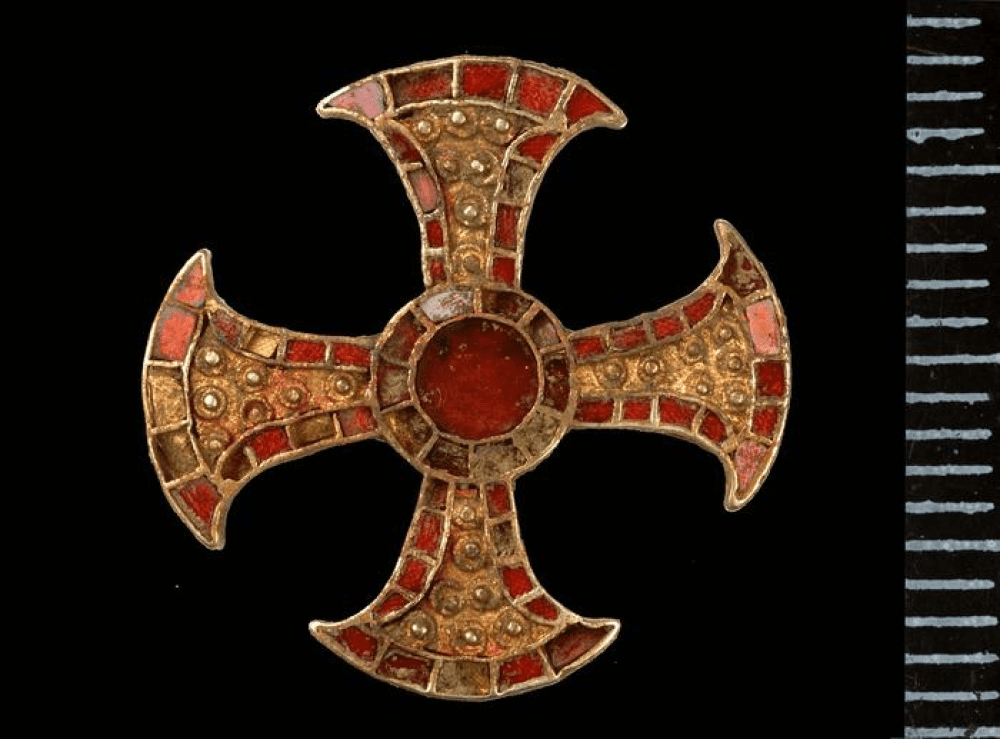The face of an Anglo-Saxon teenager found wearing an incredibly rare gold cross is to go on display following a remarkable reconstruction using skull analysis. Discovered during a dig at Trumpington Meadows in Cambridge, details found at the site revealed she was likely a Very Important Person in life, as demonstrated by the unique way in which she was buried and the rare items she was laid to rest with.
Now, her face will be exhibited at Beneath Our Feet: Archaeology of the Cambridge Region from June 21, 2023, to April 14, 2024. The major new exhibition hosted by Cambridge’s Museum of Archaeology and Anthropology will also house a gold garnet cross found around the teenager’s neck, known as the “Trumpington Cross”. It’s one of just five crosses of its kind ever found in England.
The reconstruction was made possible thanks to skull analysis that uses measurements from skeletal remains and combines them with tissue depth data for different sexes and ethnicities, in this case, a Caucasian female. Using this information, forensic artist Hew Morrison was able to create a likeness, revealing unique characteristics of the young woman’s appearance.
It was interesting to see her face developing,” said Morrison in a statement. “Her left eye was slightly lower, about half a centimetre [0.2 inches], than her right eye. This would have been quite noticeable in life.”
While artistic license had to be taken in areas such as eye and hair color due to lacking DNA evidence, it gives us the unique opportunity to look upon the face of a real Anglo-Saxon. Further analysis was also able to reveal intriguing insights into her diet, and how it changed dramatically following a move from the Alps to England around the age of seven.
The Trumpington Cross is one of just five crosses of its kind ever found in Britain.
Image credit: University of Cambridge Archaeological Unit
We know this thanks to a quirk of forensic taphonomy that really drives home the idiom, “you are what you eat”. If this is the first time you’re hearing about this, handily we recently discussed the lifestyle record that is the human skeleton with forensic taphonomist Dr Devin Finaughty of the University of Kent for the July issue of CURIOUS (out June 25 – subscribe to receive it).
“We can reconstruct a person’s diet at different stages of their lives depending on where we source the tissue from,” Finaughty told IFLScience. “Even when we’ve stopped growing it doesn’t mean that your bones just stop doing what they do.”
“Your body continues to turn over that, and it’s pulling in material from your diet as it does that. This means we can use stable isotope analysis to generate information based on your diet. Everything from the type of water you were drinking to the type of food that you were eating, all of that is written in bones.”
The same is true of our 16-year-old Anglo-Saxon, for whom isotopic analysis revealed that following her arrival in England, the amount of protein in her diet dipped by a small but significant amount. The dietary change evidently occurred close to her death, meaning that she didn’t survive for long following the big migration.
While illness may have played a role, the exact cause of death isn’t known. However, evidence remains of the remarkable way in which she was buried, laid upon a carved wooden bed wearing the Trumpington cross, as well as gold garnet pins, and fine clothing.
“The story of this young woman goes to the very heart of what our exhibition is all about – new research making visible the lives of people at pivotal moments of Cambridgeshire’s history,” said the exhibition’s co-curator, Dr Jody Joy. “[The Museum of Archaeology and Anthropology] holds one of Britain’s most important collections of Early Medieval archaeology and the Trumpington bed burial is so important. It looks like it still has much more to teach us.”
Source Link: Remarkable Reconstruction Of Anglo-Saxon Teenager's Face Achieved Using Skull Analysis
